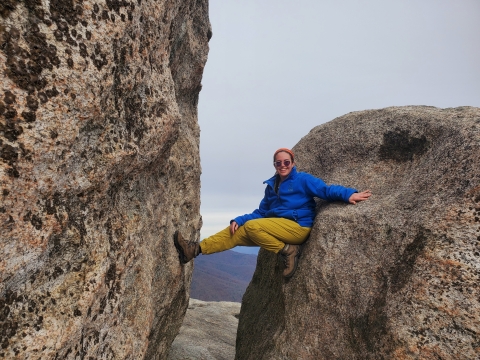In Defense of Our Natural Resources
This story is part of a series called In Defense of Our Natural Resources, highlighting the success of the Army’s partnership with the U.S. Fish and Wildlife Service. The Army has dedicated more than $13M in 2023 and 2024 to execute projects restoring habitat, preserving endangered species , and protecting critical ecosystems across 152 installations.
The Army and the U.S. Fish and Wildlife Service are committed to empowering early career professionals to take on these mission critical roles and providing valuable employment experience. This feature highlights the work of Emily Grace Thompson, Digital Media Fellow at the U.S. Fish & Wildlife Service Headquarters office in Falls Church, Virginia.
Spotlight - Emily Grace Thompson
Hi, it’s nice to meet you! I’m Emily, a Digital Media Fellow working in partnership with the Fish and Wildlife Service (USFWS) and the Army. I’m also the author of the In Defense of our Natural Resources series, and I’m excited to share my story!
What drives you to work in conservation?
I love being outside and have always loved it. You can find adventure, or peace and quiet, or anything in between out there. My best memories of time with friends and family all happened outdoors.
Conservation poses the opportunity to give back to these natural places that brought me so much comfort and growth. It’s about taking care of what takes care of us. The work is immensely satisfying and always worth doing.
For you, what’s the role of art and design in conservation?
Art and design are a facet of communication, and communication is how we make progress. All the data in the world can’t make a difference if its not presented effectively. As a designer, I find the best ways to showcase information for the audiences we’re trying to reach.
Conservation is also about connection. Art acts as a bridge, a way we can get in touch with some aspect of the natural world. Wildlife illustrations and photography spark inspiration and drive people to support natural places. I love that I can make that magic happen.
What opportunities have you had through your internship?
So, so many! It’s been an amazing ride- one day I’m attending a national conference, or taking photos, or creating content to support other interns, and another I’m illustrating an ambassador animal for a National Wildlife Refuge entrance sign. It’s incredibly varied!
Day to day, I make a lot of documents and publications, but have also started branching out to web design, contributing pages to our internal and external sites. I’m also able to get trainings in almost anything I’m interested in – lately I’ve been focused on learning the ins and outs of digital accessibility.
I’ve also been working on this project – a Story Map feature to communicate successes and illustrate how Army investments in conservation are effecting real change. I’ve interviewed other interns and their passion for the projects they’re working on is absolutely infectious. I get to be an advocate not only for these wild places, but for the people who work to protect them!
What’s your favorite aspect of your job?
The flexibility and the people. The staff that I work with at headquarters and beyond are some of the most passionate and helpful people I’ve known. The answer to any question I might have is just a teams chat or email away.
On top of that, the nature of my position as an intern through the Student Conservation Association (SCA) has provided the flexibility I need at a transitional time in my life. Last year, I completed an AmeriCorps year of service and earned an education award. I knew exactly what I wanted to do with it: Alaska.
The National Outdoor Leadership School offers a 30 day wilderness expedition for outdoor educators, split into backpacking and sea kayaking. I’d get some training in outdoor education while also checking some things off my bucket list.
SCA and FWS recognized the developmental value of the course and fully supported the time off I needed to attend. I can confidently say that the Alaska trip was the most amazing (and hardest!) thing I’ve ever done. I came away from it more empowered and inspired than ever to keep supporting real change in conservation.






